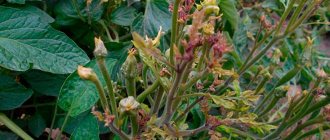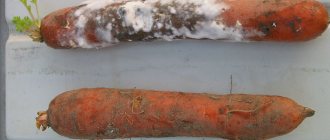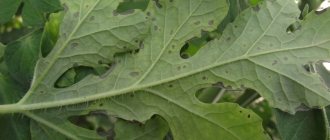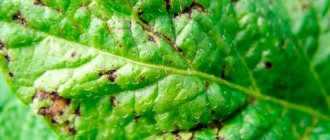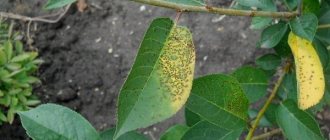Monilial burn - a disease on cherry and cherry leaves (with photo)
The causative agent of cherry leaf disease is the fungus Monilia cinerea Bonord; the disease appears in the spring. With a monilial burn, a sharp browning and drying of the ovary flowers and fruit branches occurs; young leaves also turn brown and do not fall off for a long time. A grayish coating of mycelium develops on the affected bark and leaves, the spores of which re-infect the ovaries and young shoots. You can see cherry disease in the photo further on this page, where different types of symptoms are presented.
Cherry leaf disease is most dangerous in cold spring with an abundance of precipitation, when the pathogenic fungus actively develops and the resulting branches quickly dry out. When the disease develops severely, the tree very quickly takes on the appearance of being burned, and the damage is often confused with the result of winter freezing. In stone fruits, monilial burn is manifested not only by the drying out of skeletal branches, but often leads to the rapid death of entire trees. The infection persists in the bark of the affected shoots and in dried mummified fruits.
Moniliosis
One of the most dangerous diseases of stone fruit crops. Flowers, shoots and fruits that rot after infection can be infected. The causative agents of moniliosis are most often two types of fungi - Monilinia fructigena and M. Laxa. The most characteristic sign of the disease on cherries is the drying out of flowers, which remain on the tree for a long time. The fungus then spreads to young shoots, causing them to wither and die. Massive lesions appear in rainy weather. Concentric circles consisting of small grayish-yellow mold pads become visible on the surface of the fruit. Infected fruits become mummified and remain on the tree until next year. During years of mass destruction, the fungus causes the death of most young shoots, and then the death of the entire tree. In the spring, fungal fruiting bodies are formed on the affected plant tissue - beige-gray pads of conidial sporulation, dispersing conidia throughout the garden.
Symptoms of maniliosis are often mistaken for frost damage, especially in years when the air temperature drops to sub-zero levels in early May, during the flowering of stone fruit crops. The most susceptible cherry varieties to the disease are Northstar, Kelleris and Nefris, in whose plantings symptoms of the disease can appear almost every year.
Drying of one-year cherry growth when affected by moniliosis
Control measures. Protection from the pathogen (cutting off infected shoots and chemical treatment) must be carried out during flowering. To combat moniliosis on cherries and other stone fruits, 17 fungicides are registered. The most effective are those containing tebuconazole (250 Horizon EW and its analogues) and myclobutanil (240 Talent EU). It should be taken into account that these drugs are effective at air temperatures above 12°C. At lower temperatures, it is recommended to use drugs such as Signum 33 WG, Rovra Aąuaflo 500 SC, Switch 62.5 WG or Topsin V 500 SC. You can also use other drugs - 250 EC and its analogues, Kaptan Plus 71.5 WP CZJ. The use of copper-containing protective agents is justified if at the same time it is necessary to fight other diseases, for example, when gum and bacterial cancer appear on trees.
In years with high rainfall, it is especially important to treat the garden during the period of fruit growth and coloring. Fungicides can be from different chemical groups, which need to be used alternately, up to 3 times during the season - every 10 - 14 days, and before harvesting the fruit, which will keep the garden free from infection.
Gommosis is a disease of cherry and cherry trees.
A non-infectious disease of the cherry tree, which is manifested by the abundant formation of gum in the crevices of the bark without visible necrosis and the formation of ulcers. The release of gum during gommosis is a reaction of tissues to the influence of various unfavorable factors, such as increased acidity and waterlogging of soils, excessive doses of fertilizers, incompatibility of the scion with the rootstock, low temperature, low or too high humidity.
Mechanical damage to the bark and the spread of infectious diseases, many of whose pathogens produce toxins, play a major role in the development of cherry tree disease. Biochemical processes in tissues are disrupted, the growth and development of young shoots is suspended. Gum is a product of the breakdown of cell membranes; it flows to the surface in the form of a sweetish solidifying liquid. Excessive gum production causes drying out of young shoots and even entire trees.
Control measures. Compliance with all agrotechnical requirements for growing this crop, prevention of mechanical damage, frost damage and protection from sun-frost burns. Disinfection of saw cuts with a 1% solution of copper sulfate with the obligatory sealing with oil paint. Liming of acidic soils. Preventive spraying of trees annually in the spring, before leaves bloom, with copper-containing preparations against a complex of pathogenic microorganisms.
Rust
The symptoms of rust are indicated by its name - cherry leaves become covered with lumpy orange spots. This is a fungus that is most often carried by conifers, so avoid this kind of environment. For prevention in the fall, spray trees with copper sulfate, and for treatment use Skor, Hom or similar preparations.
Photo: sarahlovescoffee.wordpress.com
Did you like the post? Subscribe to our channel in Yandex.Zen, it really helps us in our development!
Coccomycosis - a disease of cherry berries
The causative agent of this cherry berry disease is the fungus Coccomyces hiemalis Higgins (syn. Blumeriella hiemalis Poeldmaa) . Spotting occurs on almost all stone fruit crops, but most severely on cherries and sweet cherries. Numerous small scattered dark brown spots appear on the upper side of the leaf. On the underside of these spots, pinkish-white sporulation pads develop in the necrotic tissue, spores from which re-infect neighboring leaves and fruits.
With coccomycosis, whitish pustules with pinkish edges appear on the petioles of fruits, and depressed brown spots with a whitish coating appear on the fruits. Spotting appears from the first half of June and, if widespread, can cause premature leaf fall, which significantly reduces the winter hardiness of trees. The infection persists on affected fallen leaves.
Try cherry varieties from a trusted supplier:

